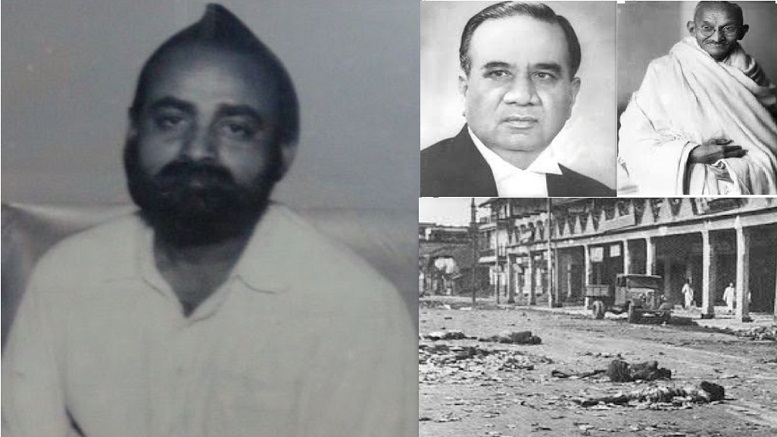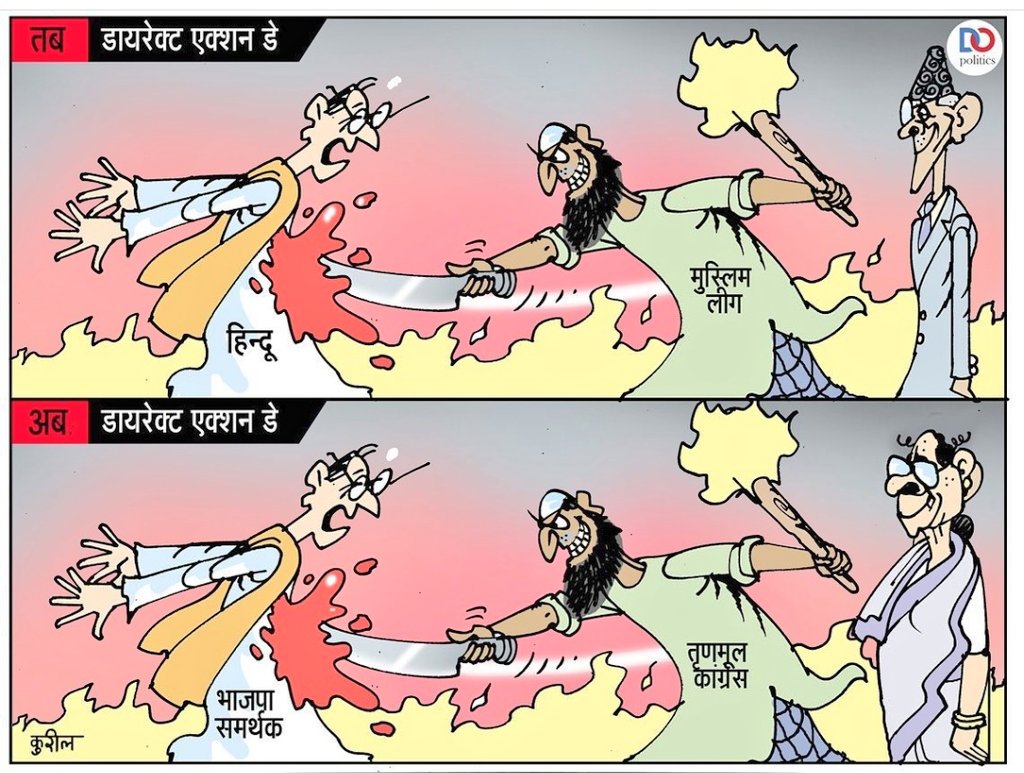S
Shruti Dasgupta
Guest
In August 1947, the British divided Bharat into two nations and three parts. This division was fuelled by the violence that had enflamed the country in the name of Direct Action Day. 10,000 victims lost their lives or property as the ‘secular’ All India Muslim League (AIML) declared war on the people of India. The violence was under the guise of a demand for a separate Muslim-majority country.

PC The Dharma Dispatch
On August 16, 1946, the AIML, led by Muhammad Ali Jinnah, declared “Direct Action Day.” This was to oppose the Britishers’ decision to divide India into Hindu-majority and Muslim-majority states. Such a plan would have left Bharat undivided. The Congress and AIML both opposed this decision at the time. However, the ‘peacefuls’ took to violence to showcase their inability to live in Bharat in harmony with Hindus. The ensuing riots left a mark in the hearts of the Hindus. Unsurprisingly, ‘peacefuls’ and their leaders used these riots to justify slicing India into parts.

PC HindPost
History marks the initial intention of the AIML as a peaceful political demonstration. However, the reality was a day of violent clashes between Hindu -Muslim communities in Calcutta. The riots that started in Calcutta soon spread to Bihar, Noakhali, and Punjab. The cities of India witnessed horrific riots, resulting in the loss of thousands of lives, widespread destruction of property, and the displacement of countless families. The violence deepened the communal divide in Bharat.
Thus, it was the first instance of ‘victimhood’ in the name of religion. The obvious incitement of the Muslim community by the AIML was ignored, the divisive politics in play was disregarded, and the true selfishness of Jinnah’s ambition was underplayed. The British used these events to carve Bharat into India, Pakistan, and current-day Bangladesh.
This violence was the first instance of Muslim victimhood while being the true perpetrators of communal violence. The consequence of Direct Action Day is the versions of communal clashes still visible in parts of India, where the ‘peacefuls’ play the victim while instigating lynching, torching, and mayhem in the name of Islam.
Muslim leaders linked the Direct Action to significant historical battles fought during Ramzan, such as the Battle of Badr. Even today, such religious connection incites violence in ‘peacefuls’. Consequently, they are easily molded by anti-India elements. Muslims often rally behind any cause under the banner of religion. Thus, religious leaders also have a huge role to play in any communal riots incited by ‘peacefuls’. A call for action colored in religious sentiments in today’s India is called ‘Jihad’.

PC X @ Raj Pushpa Awasthi
Direct Action Day is a reminder of the consequences of divisive politics in play in the land of Bharat. It stands as a testament to the sacrifices made by innocent Hindus while ‘peacefuls’ play the victim card in the name of religion. The modus operandi has never changed with the passage of time. The tragedy of 1946 reiterates that tolerance, unity, and the non-violence were paid lip service by the Muslim leaders to divide India. Moreover, it reminds Indians to connect the dots to spurts of anti-Hindu riots that often occur in India. These riots are always related to religion, they are alway against Hindus in the region, and the authorities alway let the ‘peacefuls’ off as ‘victims’.
Additionally, a consequence of Direct Action Day is that the ‘peacefuls’ have a tried-and-tested way to make the ‘apologists’ of the nation bow to their demands. Moreover, the pseudo-secular politicians fuel communal fires in the nation. This ensures that votes are cast in the name of religion and not progress. Therefore, the dark chapter of Direct Action Day in Indian history is the first instance of appeasement politics. Moreover, the only ‘losers’ in this game of power and minority-driven policies are the Hindus. Consequently, the riots and violence that plague India reminds Hindus to pay the price in the name of fragile communal harmony. It also reminds us that Hindus, despite being in the majority, always pay a high price in the name of communal peace and secularism.
The post ‘Direct Action Day’ : Lessons for Bharat appeared first on The Jaipur Dialogues.
Continue reading...

PC The Dharma Dispatch
On August 16, 1946, the AIML, led by Muhammad Ali Jinnah, declared “Direct Action Day.” This was to oppose the Britishers’ decision to divide India into Hindu-majority and Muslim-majority states. Such a plan would have left Bharat undivided. The Congress and AIML both opposed this decision at the time. However, the ‘peacefuls’ took to violence to showcase their inability to live in Bharat in harmony with Hindus. The ensuing riots left a mark in the hearts of the Hindus. Unsurprisingly, ‘peacefuls’ and their leaders used these riots to justify slicing India into parts.
Political Demonstration or Call for Violence?

PC HindPost
History marks the initial intention of the AIML as a peaceful political demonstration. However, the reality was a day of violent clashes between Hindu -Muslim communities in Calcutta. The riots that started in Calcutta soon spread to Bihar, Noakhali, and Punjab. The cities of India witnessed horrific riots, resulting in the loss of thousands of lives, widespread destruction of property, and the displacement of countless families. The violence deepened the communal divide in Bharat.
The ‘secular’ and ‘peaceful’ AIML used the brutal clashes of Direct Action Day as the excuse to create Pakistan. Moreover, Muslims used this Direct Action Day to project insecurity using the minority card.
Thus, it was the first instance of ‘victimhood’ in the name of religion. The obvious incitement of the Muslim community by the AIML was ignored, the divisive politics in play was disregarded, and the true selfishness of Jinnah’s ambition was underplayed. The British used these events to carve Bharat into India, Pakistan, and current-day Bangladesh.
This violence was the first instance of Muslim victimhood while being the true perpetrators of communal violence. The consequence of Direct Action Day is the versions of communal clashes still visible in parts of India, where the ‘peacefuls’ play the victim while instigating lynching, torching, and mayhem in the name of Islam.
Lessons For Bharat Today
Muslim leaders linked the Direct Action to significant historical battles fought during Ramzan, such as the Battle of Badr. Even today, such religious connection incites violence in ‘peacefuls’. Consequently, they are easily molded by anti-India elements. Muslims often rally behind any cause under the banner of religion. Thus, religious leaders also have a huge role to play in any communal riots incited by ‘peacefuls’. A call for action colored in religious sentiments in today’s India is called ‘Jihad’.

PC X @ Raj Pushpa Awasthi
Direct Action Day is a reminder of the consequences of divisive politics in play in the land of Bharat. It stands as a testament to the sacrifices made by innocent Hindus while ‘peacefuls’ play the victim card in the name of religion. The modus operandi has never changed with the passage of time. The tragedy of 1946 reiterates that tolerance, unity, and the non-violence were paid lip service by the Muslim leaders to divide India. Moreover, it reminds Indians to connect the dots to spurts of anti-Hindu riots that often occur in India. These riots are always related to religion, they are alway against Hindus in the region, and the authorities alway let the ‘peacefuls’ off as ‘victims’.
Additionally, a consequence of Direct Action Day is that the ‘peacefuls’ have a tried-and-tested way to make the ‘apologists’ of the nation bow to their demands. Moreover, the pseudo-secular politicians fuel communal fires in the nation. This ensures that votes are cast in the name of religion and not progress. Therefore, the dark chapter of Direct Action Day in Indian history is the first instance of appeasement politics. Moreover, the only ‘losers’ in this game of power and minority-driven policies are the Hindus. Consequently, the riots and violence that plague India reminds Hindus to pay the price in the name of fragile communal harmony. It also reminds us that Hindus, despite being in the majority, always pay a high price in the name of communal peace and secularism.
The post ‘Direct Action Day’ : Lessons for Bharat appeared first on The Jaipur Dialogues.
Continue reading...
